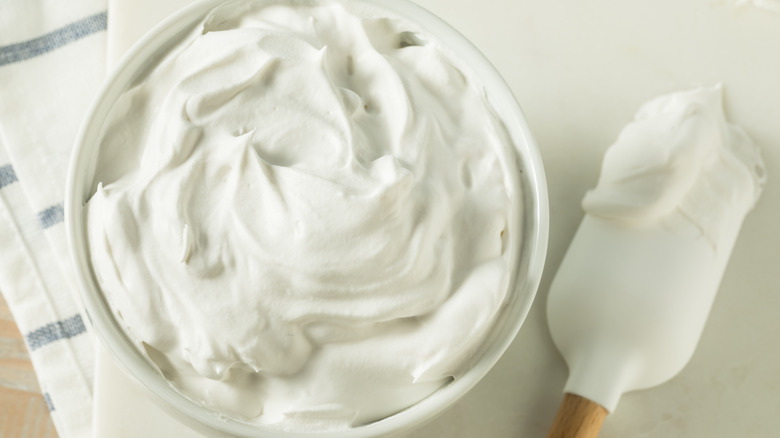Balance Out Ultra-Sweet Baked Goods With Greek Yogurt Frosting
Sweetness is a key part of many baked goods, but an overly sugary flavor can be off-putting, and that can often happen once you add frosting. To achieve a less sweet outcome, many recipes call for using cream cheese as opposed to butter since its slight tang can offset the high amount of powdered sugar. However, a much more effective approach is to swap it for Greek yogurt instead.
Greek yogurt frosting isn't as sweet because its main ingredient — yogurt — is a combination of yogurt cultures and fermented milk, which form a naturally sour combination. On a chemical level, sourness and sweetness neutralize each other, and that means when you use Greek yogurt as the base of a frosting and add it to a sweet baked good, the result is perfectly balanced. This substitution allows you to maintain the same rich and creamy texture of frosting with minimal effect on the dessert's pre-existing sweetness.
How to turn Greek yogurt into frosting
Turning Greek yogurt into frosting depends on how much sweetness you want to use and the consistency you want to achieve. The Greek yogurt frosting of these gingerbread cookies, for example, calls for Greek yogurt combined with butter, coconut oil, and molasses. Since molasses is the only source of sugar, this combination produces a frosting that is mild in sweetness, but on the runnier side. It works on a cookie, but might not hold up as well if you piped it onto a cake or cupcake.
For a firmer frosting, you would have to add 1 cup of powdered sugar to 2 cups of Greek yogurt, much like you would a buttercream or cream cheese frosting. Although Greek yogurt is sour, powdered sugar will add some sweetness, and because it contains cornstarch, it also gives frosting a thicker consistency. As you would with any frosting, you can taste as you go and add more or less of an ingredient depending on your taste and texture preferences.
What's the best type of Greek yogurt for frosting?
The best type of Greek yogurt for frosting is the full-fat, plain kind because it's thicker than low-fat Greek yogurt and gives you more control over the sweetness compared to sweetened Greek yogurt. Greek-style yogurt, which is actually different from traditional Greek yogurt, is also an ideal thickness for frosting, but keep in mind it is thickened artificially with pectin and contains more sugar. Flavored Greek yogurt will work just as well, or you can add your own flavoring, such as vanilla extract or cocoa powder, to the plain variety.
If you insist on using low-fat Greek yogurt, or even if you just want to make full-fat Greek yogurt extra thick, you can always add a stabilizer such as xanthan gum. It also helps to strain it overnight through a coffee filter or cheesecloth. Greek yogurt already comes strained which is part of why it's thicker than regular yogurt, but an additional straining can effectively get rid of excess moisture so it results in a frosting with both an ideal texture and taste.


